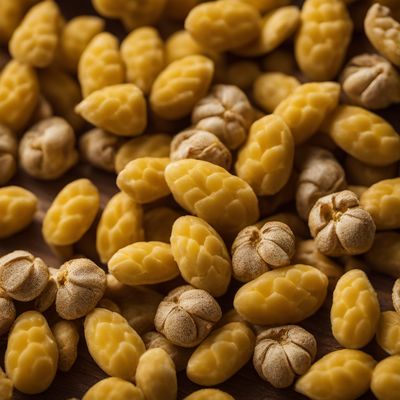
Ingredient
Andean lupin (dry)
The Ancient Andean Superfood
Andean lupin is a small, oval-shaped legume with a firm texture and a slightly bitter taste. When cooked, it becomes tender and develops a nutty flavor. The outer skin of the lupin bean is often removed before consumption, as it can be tough and slightly bitter. Andean lupin is commonly used in soups, stews, salads, and as a snack food.
Origins and history
Andean lupin has a long history of cultivation in the Andean region of South America, particularly in Peru, Bolivia, and Ecuador. It has been a staple food for indigenous communities for thousands of years, providing a valuable source of protein, fiber, and essential nutrients. Andean lupin holds cultural significance and is often used in traditional celebrations and rituals. It is also considered an important crop for sustainable agriculture due to its ability to fix nitrogen in the soil and its resistance to pests and diseases.
Nutritional information
Andean lupin is a nutrient-dense ingredient, rich in protein, dietary fiber, and essential minerals such as iron, magnesium, and potassium. It is also low in fat and cholesterol. A 1/4 cup (40g) serving of cooked Andean lupin provides approximately 120 calories, 10 grams of protein, and 7 grams of dietary fiber.
Allergens
May contain lupin allergens.
How to select
When selecting Andean lupin, look for dried lupini beans that are clean, free from mold or insect damage, and have a uniform size and color. Avoid beans that appear discolored, shriveled, or have a strong odor. If possible, opt for organic or sustainably grown Andean lupin to support environmentally friendly farming practices.
Storage recommendations
To maintain the freshness and quality of Andean lupin, store the dried beans in an airtight container in a cool, dry place. Avoid exposure to moisture, as it can cause the beans to spoil or develop mold. Cooked Andean lupin can be stored in the refrigerator for up to 5 days. If storing for a longer period, consider freezing the cooked beans in airtight containers or freezer bags.
How to produce
Andean lupin can be grown in home gardens or small-scale farms with proper soil preparation and irrigation. It requires well-drained soil and full sun exposure. The lupin seeds can be sown directly into the ground or started indoors and transplanted once the seedlings are established. Regular watering and occasional fertilization are necessary for optimal growth. Harvest the lupin pods when they turn yellow and dry them thoroughly before removing the outer skin and cooking the beans.
Preparation tips
Before using Andean lupin, it is important to remove the outer skin, as it can be tough and slightly bitter. This can be done by soaking the dried beans in water for several days, changing the water daily to remove the bitterness. Once the outer skin is easily removable, drain the beans and cook them in boiling water until tender. Andean lupin can be used in a variety of dishes, including soups, stews, salads, and as a snack. It can also be ground into flour and used in baking recipes.
Substitutions
Chickpeas, fava beans
Culinary uses
Andean lupin is commonly used in traditional Andean cuisine, particularly in Peru, Bolivia, and Ecuador. It is used in soups, stews, and salads, often paired with other local ingredients such as potatoes, corn, and quinoa. Andean lupin is also enjoyed as a snack, either boiled or pickled. In some regions, it is ground into flour and used to make bread, pancakes, and other baked goods.
Availability
Andean lupin is primarily cultivated in the Andean region of South America, particularly in Peru, Bolivia, and Ecuador. It is also grown in other parts of the world, including Europe, Australia, and New Zealand. Andean lupin is commonly available in local markets and specialty stores in these regions.


